Coupling Raman, Brillouin and Nd3+ Photo Luminescence Spectroscopy to Distinguish the Effect of Uniaxial Stress from Cooling Rate on Soda–Lime Silicate Glass
Abstract
:1. Introduction
2. Materials and Methods
2.1. Correlation of Cooling Rate to the Fictive Temperature
2.2. Generation of Glasses with Different Cooling Rates
2.3. In Situ Observation during Uniaxial Compression
2.4. Vibrational Analysis
2.4.1. Raman Spectroscopy
2.4.2. Brillouin Spectroscopy
2.5. Neodymium3+ (Nd3+) Luminescence
3. Results and Discussion
3.1. Calibration of the Raman Response
3.2. Calibration of the Brillouin Response
3.3. Calibration of the Nd3+ Photoluminescence Response
3.4. Non-Destructive Cooling Rate and Residual Stress Determination
4. Conclusions
Author Contributions
Funding
Institutional Review Board Statement
Informed Consent Statement
Data Availability Statement
Acknowledgments
Conflicts of Interest
Appendix A
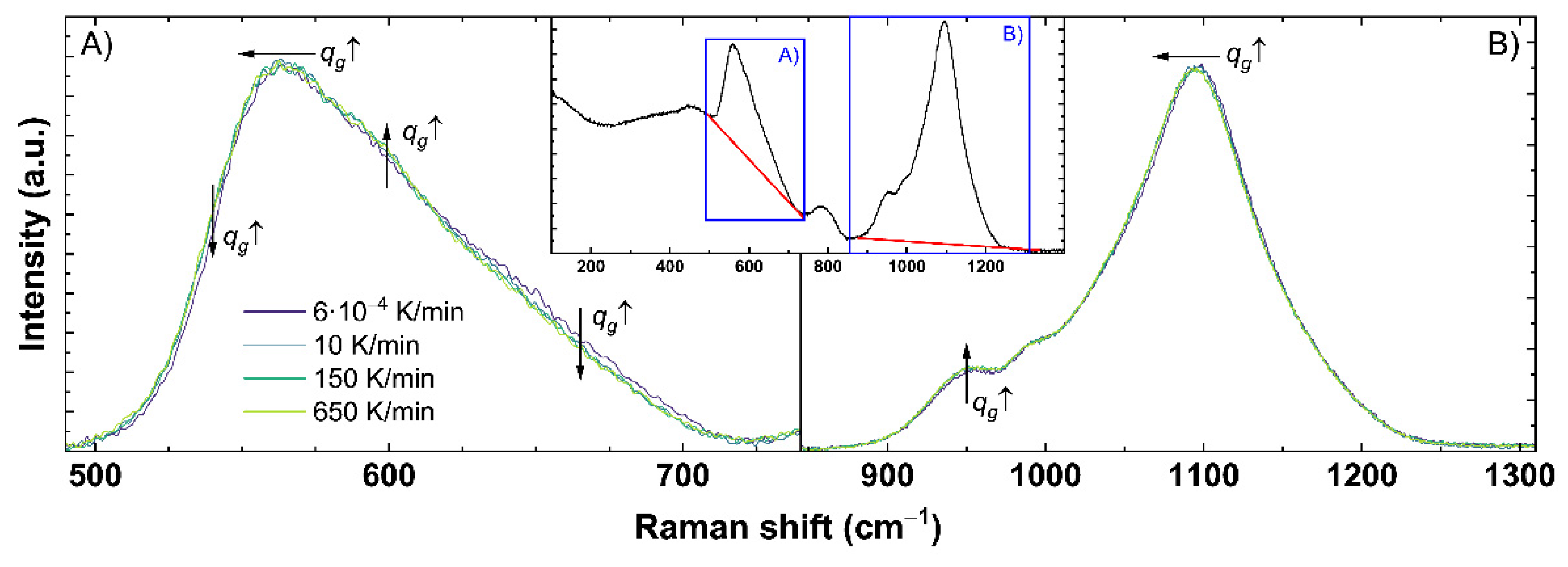
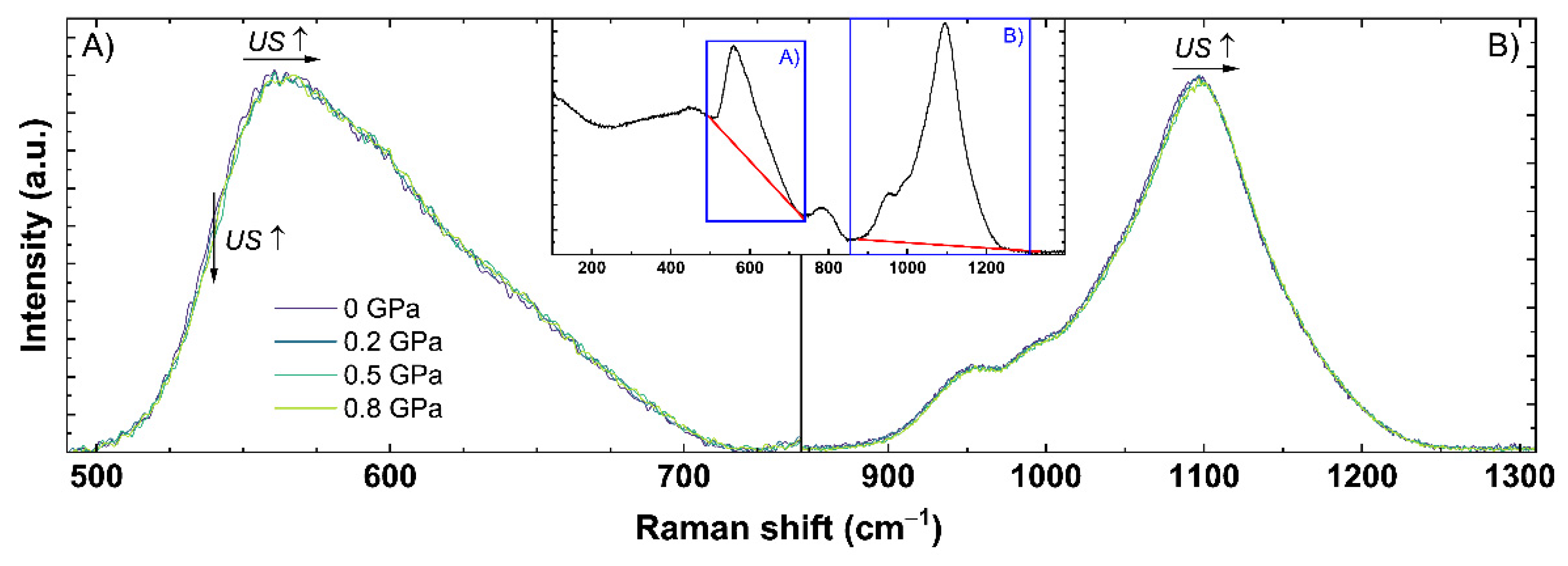
| log10(qg) | US | σMB | MPQ | BR | σNd |
|---|---|---|---|---|---|
| (K/min) | (GPa) | (cm−1) | (cm−1) | (GHz) | (cm−1) |
| ±0.01 | ±0.001 | ±0.2 | ±0.2 | ±0.03 | ±0.2 |
| −3.222 | 0 | 588.4 | 1097.1 | 36.95 | 11,263.6 |
| −0.301 | 0 | 587.1 | 1095.8 | 36.76 | 11,259.9 |
| 0.000 | 0 | 586.9 | 1095.9 | 36.72 | 11,259.8 |
| 0.699 | 0 | 586.7 | 1095.2 | 36.66 | 11,258.5 |
| 1.000 | 0 | 586.6 | 1095.6 | 36.63 | 11,258.1 |
| 1.301 | 0 | 586.4 | 1094.9 | 36.60 | 11,257.2 |
| 1.699 | 0 | 586.3 | 1095.1 | 36.58 | 11,256.9 |
| 2.176 | 0 | 586.2 | 1094.9 | 36.54 | 11,256.1 |
| 2.477 | 0 | 586.0 | 1095.0 | 36.49 | 11,255.5 |
| 2.813 | 0 | 585.9 | 1094.6 | 36.45 | 11,254.1 |
| log10(qg) | US | σMB | MPQ | BR | σNd |
|---|---|---|---|---|---|
| (K/min) | (GPa) | (cm−1) | (cm−1) | (GHz) | (cm−1) |
| ±0.001 | ±0.001 | ±0.2 | ±0.2 | ±0.03 | ±0.2 |
| −3.222 | 0 | 588.4 | 1097.1 | 36.95 | 11,263.6 |
| −0.301 | 0 | 587.1 | 1095.8 | 36.76 | 11,259.9 |
| 0.000 | 0 | 586.9 | 1095.9 | 36.72 | 11,259.8 |
| 0.699 | 0 | 586.7 | 1095.2 | 36.66 | 11,258.5 |
| 1.000 | 0 | 586.6 | 1095.6 | 36.63 | 11,258.1 |
| 1.301 | 0 | 586.4 | 1094.9 | 36.60 | 11,257.2 |
| 1.699 | 0 | 586.3 | 1095.1 | 36.58 | 11,256.9 |
| 2.176 | 0 | 586.2 | 1094.9 | 36.54 | 11,256.1 |
| 2.477 | 0 | 586.0 | 1095.0 | 36.49 | 11,255.5 |
| 2.813 | 0 | 585.9 | 1094.6 | 36.45 | 11,254.1 |
| log10(qg) | US | σMB | MPQ | BR | σNd |
|---|---|---|---|---|---|
| (K/min) | (GPa) | (cm−1) | (cm−1) | (GHz) | (cm−1) |
| ±0.001 | ±0.001 | ±0.2 | ±0.2 | ±0.03 | ±0.2 |
| 1 | 0.000 | 586.6 | 1095.2 | 36.58 | 11,258.1 |
| 1 | 0.050 | 586.9 | 1095.6 | 36.59 | 11,257.9 |
| 1 | 0.100 | 586.6 | 1095.6 | 36.64 | 11,257.6 |
| 1 | 0.150 | 587.0 | 1096.1 | 36.65 | 11,257.5 |
| 1 | 0.200 | 586.9 | 1096.1 | 36.67 | 11,257.4 |
| 1 | 0.250 | 587.1 | 1096.6 | 36.73 | 11,256.9 |
| 1 | 0.300 | 587.1 | 1096.8 | 36.76 | 11,256.1 |
| 1 | 0.350 | 586.9 | 1096.7 | 36.72 | 11,256.3 |
| 1 | 0.400 | 586.8 | 1096.5 | 36.73 | 11,255.5 |
| 1 | 0.450 | 586.9 | 1096.8 | 36.72 | 11,255.1 |
| 1 | 0.500 | 587.0 | 1096.9 | 36.80 | 11,254.6 |
| 1 | 0.550 | 587.0 | 1096.6 | 36.70 | 11,254.2 |
| 1 | 0.600 | 586.9 | 1097.2 | 36.71 | 11,253.5 |
| 1 | 0.650 | 587.5 | 1097.6 | 36.77 | 11,253.8 |
| 1 | 0.700 | 587.4 | 1097.9 | 36.81 | 11,253.1 |
| 1 | 0.750 | 587.3 | 1097.6 | 36.73 | 11,253.3 |
| 1 | 0.800 | 587.3 | 1098.0 | 36.80 | 11,253.0 |
| log10(qg) | US | σMB | MPQ | BR | σNd |
|---|---|---|---|---|---|
| (K/min) | (GPa) | (cm−1) | (cm−1) | (GHz) | (cm−1) |
| ±0.001 | ±0.001 | ±0.2 | ±0.2 | ±0.03 | ±0.2 |
| −3.222 | 0.000 | 588.5 | 1097.2 | 36.95 | 11,263.7 |
| −3.222 | 0.050 | 588.9 | 1097.4 | 36.97 | 11,263.1 |
| −3.222 | 0.100 | 588.7 | 1097.3 | 36.98 | 11,262.9 |
| −3.222 | 0.150 | 589.0 | 1097.7 | 36.98 | 11,262.4 |
| −3.222 | 0.200 | 588.6 | 1097.8 | 36.98 | 11,262.1 |
| −3.222 | 0.250 | 588.9 | 1097.8 | 37.00 | 11,261.7 |
| −3.222 | 0.300 | 588.8 | 1098.3 | 37.09 | 11,261.1 |
| −3.222 | 0.350 | 588.9 | 1098.3 | 37.06 | 11,260.3 |
| −3.222 | 0.400 | 589.1 | 1098.3 | 37.08 | 11,260.2 |
| −3.222 | 0.450 | 588.9 | 1099.3 | 37.13 | 11,260.1 |
| −3.222 | 0.500 | 589.1 | 1099.3 | 37.11 | 11,260.1 |
| −3.222 | 0.550 | 588.9 | 1099.4 | 37.13 | 11,259.3 |
| −3.222 | 0.600 | 589.2 | 1099.7 | 37.14 | 11,258.5 |
| −3.222 | 0.650 | 589.0 | 1100.0 | 37.16 | 11,258.5 |
| −3.222 | 0.700 | 589.2 | 1100.0 | 37.18 | 11,258.4 |
| −3.222 | 0.750 | 589.3 | 1100.4 | 37.18 | 11,258.0 |
| −3.222 | 0.800 | 589.2 | 1100.4 | 37.18 | 11,257.7 |
References
- Nisar, S.; Li, L.; Sheikh, M.A. Laser glass cutting techniques—A review. J. Laser Appl. 2013, 25, 42010. [Google Scholar] [CrossRef]
- Werr, F.; Veber, A.; Brehl, M.; Bergler, M.; Werner, D.; Eppelt, U.; Müllers, L.; de Ligny, D. Surface Probing of Ultra-Short-Pulse Laser Filament Cut Window Glass and the Impact on the Separation Behavior. Adv. Eng. Mater. 2020, 22, 2000471. [Google Scholar] [CrossRef]
- Peters, D.; Drallmeier, J.; Bristow, D.A.; Landers, R.G.; Kinzel, E. Sensing and control in glass additive manufacturing. Mechatronics 2018, 56, 188–197. [Google Scholar] [CrossRef]
- Von Witzendorff, P.; Pohl, L.; Suttmann, O.; Heinrich, P.; Heinrich, A.; Zander, J.; Bragard, H.; Kaierle, S. Additive manufacturing of glass: CO2-Laser glass deposition printing. Procedia CIRP 2018, 74, 272–275. [Google Scholar] [CrossRef]
- Datsiou, K.C.; Saleh, E.; Spirrett, F.; Goodridge, R.; Ashcroft, I.; Eustice, D. Additive manufacturing of glass with laser powder bed fusion. J. Am. Ceram. Soc. 2019, 102, 4410–4414. [Google Scholar] [CrossRef] [Green Version]
- Liao, Y.; Song, J.; Li, E.; Luo, Y.; Shen, Y.; Chen, D.; Cheng, Y.; Xu, Z.; Sugioka, K.; Midorikawa, K. Rapid prototyping of three-dimensional microfluidic mixers in glass by femtosecond laser direct writing. Lab Chip Miniat. Chem. Biol. 2012, 12, 746–749. [Google Scholar] [CrossRef]
- Weingarten, C.; Schmickler, A.; Willenborg, E.; Wissenbach, K.; Poprawe, R. Laser polishing and laser shape correction of optical glass. J. Laser Appl. 2017, 29, 11702. [Google Scholar] [CrossRef] [Green Version]
- Zhou, T.; Liu, X.; Liang, Z.; Liu, Y.; Xie, J.; Wang, X. Recent advancements in optical microstructure fabrication through glass molding process. Front. Mech. Eng. 2017, 12, 46–65. [Google Scholar] [CrossRef] [Green Version]
- Jochs, W.W.; Hoffmann, H.J.; Neuroth, N.M. The effects of thermal treatment below the glass transition temperature on the refractive index of optical glass. J. Non Cryst. Solids 1988, 102, 255–258. [Google Scholar] [CrossRef]
- Zimmermann, F.; Lancry, M.; Plech, A.; Richter, S.; Ullsperger, T.; Poumellec, B.; Tünnermann, A.; Nolte, S. Ultrashort pulse laser processing of silica at high repetition rates—From network change to residual strain. Int. J. Appl. Glass Sci. 2017, 8, 233–238. [Google Scholar] [CrossRef]
- Bergler, M.; Cvecek, K.; Werr, F.; Brehl, M.; de Ligny, D.; Schmidt, M. Cooling rate calibration and mapping of ultra-short pulsed laser modifications in fused silica by Raman and Brillouin spectroscopy. Int. J. Extrem. Manuf. 2020, 2, 35001. [Google Scholar] [CrossRef]
- Li, C.-Y.; Tomozawa, M. Fictive temperature and fictive pressure measurement of silica glasses using FTIR method: For thick samples and samples containing Si–H. J. Non Cryst. Solids 2012, 358, 3365–3371. [Google Scholar] [CrossRef]
- Badrinarayanan, P.; Zheng, W.; Li, Q.; Simon, S.L. The glass transition temperature versus the fictive temperature. J. Non Cryst. Solids 2007, 353, 2603–2612. [Google Scholar] [CrossRef]
- Caponi, S.; Fontana, A.; Mattarelli, M.; Montagna, M.; Rossi, F. The influence of the fictive temperature and the OH content on the dynamical properties of vitreous silica: Comparison of Raman, Brillouin, and neutron scattering spectra. J. Phys. Condens. Matter. 2007, 19, 205149. [Google Scholar] [CrossRef]
- Deschamps, T.; Martinet, C.; de Ligny, D.; Champagnon, B. Elastic anomalous behavior of silica glass under high-pressure: In-situ Raman study. J. Non Cryst. Solids 2009, 355, 1095–1098. [Google Scholar] [CrossRef]
- Sonneville, C.; Mermet, A.; Champagnon, B.; Martinet, C.; Margueritat, J.; de Ligny, D.; Deschamps, T.; Balima, F. Progressive transformations of silica glass upon densification. J. Chem. Phys. 2012, 137, 124505. [Google Scholar] [CrossRef]
- Deschamps, T.; Margueritat, J.; Martinet, C.; Mermet, A.; Champagnon, B. Elastic moduli of permanently densified silica glasses. Sci. Rep. 2014, 4, 7193. [Google Scholar] [CrossRef] [Green Version]
- Musgraves, J.D.; Hu, J.; Calvez, L. Springer Handbook of Glass, 1st ed.; Springer International Publishing: Cham, Switzerland, 2019; pp. 441–448. [Google Scholar] [CrossRef]
- Technical Bulletin. Properties of Soda-Lime Silica Float Glass. 2013. Available online: https://www.pilkington.com/-/media/pilkington/site-content/usa/window-manufacturers/technical-bulletins/ats129propertiesofglass20130114.pdf (accessed on 12 January 2020).
- Gutzow, I.S.; Mazurin, O.V.; Schmelzer, J.W.P.; Todorova, S.V.; Petroff, B.B.; Priven, A.I. Glasses and the Glass Transition; WILEY-VCH Verlag: Weinheim, Germany, 2011; pp. 108–110. [Google Scholar] [CrossRef]
- Tool, A.Q.; Eicitlin, C.G. Variations caused in heating curves of glass by heat treatment. J. Am. Ceram. Soc. 1931, 14, 276–308. [Google Scholar] [CrossRef]
- Tool, A.Q. Relaxation of stresses in annealing glass. J. Res. Natl. Bur. Stand. 1945, 34, 199–215. [Google Scholar] [CrossRef]
- Tool, A.Q. Relation between inelastic deformability and thermal expansion of glass in its annealing range. J. Am. Ceram. Soc. 1946, 29, 240–253. [Google Scholar] [CrossRef]
- Sipp, A.; Richet, P. Equivalence of volume, enthalpy and viscosity relaxation kinetics in glass-forming silicate liquids. J. Non Cryst. Solids 2002, 298, 202–212. [Google Scholar] [CrossRef]
- Moynihan, C.T.; Easteal, A.J.; Wilder, J.; Tucker, J. Dependence of the glass transition temperature on heating and cooling rate. J. Phys. Chem. 1974, 78, 2673–2677. [Google Scholar] [CrossRef]
- Yue, Y.; von der Ohe, R.; Jensen, S.L. Fictive temperature, cooling rate, and viscosity of glasses. J. Chem. Phys. 2004, 120, 8053–8059. [Google Scholar] [CrossRef]
- Yue, Y.-Z. Characteristic temperatures of enthalpy relaxation in glass. J. Non Cryst. Solids 2008, 354, 1112–1118. [Google Scholar] [CrossRef]
- Veber, A.; Cicconi, M.R.; Reinfelder, H.; de Ligny, D. Combined Differential scanning calorimetry, Raman and Brillouin spectroscopies: A multiscale approach for materials investigation. Anal. Chim. Acta 2018, 998, 37–44. [Google Scholar] [CrossRef]
- Uhlmann, D.R.; Kreidl, N.J. (Eds.) Glass Science and Technology: Viscosity and Relaxation, 1st ed.; Academic Press Inc.: Orlando, FL, USA, 1986. [Google Scholar]
- Kaur, A.; Khanna, A.; Hirdesh; Gonzàlez-Barriuso, M.; Gonzàlez, F. Effects of annealing on density, glass transition temperature and structure of tellurite, silicate and borate glasses. J. Non Cryst. Solids 2018, 500, 443–452. [Google Scholar] [CrossRef]
- Brawer, S.A.; White, W.B. Raman spectroscopic investigation of the structure of silicate glasses. I. The binary alkali silicates. J. Chem. Phys. 1975, 63, 2421–2432. [Google Scholar] [CrossRef]
- Mysen, B.O.; Virgo, D.; Scarfe, C.M. Relations between the anionic structure and viscosity of silicate melts—A Raman spectroscopic study. Am. Mineral. 1980, 65, 690–710. [Google Scholar]
- Matson, D.W.; Sharma, S.K.; Philpotts, J.A. The structure of high-silica alkali-silicate glasses. A Raman spectroscopic investigation. J. Non Cryst. Solids 1983, 58, 323–352. [Google Scholar] [CrossRef]
- Dickinson, J.E., Jr.; Scarfe, C.M.; McMillan, P. Physical properties and structure of K2Si4O9 melt quenched from pressures up to 2.4 GPa. J. Geophys. Res. 1990, 95, 15675–15681. [Google Scholar] [CrossRef]
- Xue, X.Y.; Stebbins, J.F.; Kanzaki, M.; McMillan, P.F.; Poe, B. Pressure-induced silicon coordination and tetrahedral structural changes in alkali oxide-silica melts up to 12 GPa: NMR, Raman, and infrared spectroscopy. Am. Mineral. 1991, 76, 8–26. [Google Scholar]
- Galeener, F.L. Planar rings in glasses. Solid State Commun. 1982, 44, 1037–1040. [Google Scholar] [CrossRef]
- Hehlen, B. Inter-tetrahedra bond angle of permanently densified silicas extracted from their Raman spectra. J. Phys. Condens. Matter. 2010, 22, 25401. [Google Scholar] [CrossRef] [PubMed]
- Bancroft, G.M.; Nesbitt, H.W.; Henderson, G.S.; O’Shaughnessy, C.; Withers, A.C.; Neuville, D.R. Lorentzian dominated lineshapes and linewidths for Raman symmetric stretch peaks (800–1200 cm−1) in Qn (n = 1–3) species of alkali silicate glasses/melts. J. Non Cryst. Solids 2018, 484, 72–83. [Google Scholar] [CrossRef]
- O’Shaughnessy, C.; Henderson, G.S.; Nesbitt, H.W.; Bancroft, G.M.; Neuville, D.R. The influence of modifier cations on the Raman stretching modes of Qn species in alkali silicate glasses. J. Am. Ceram. Soc. 2020, 103, 3991–4001. [Google Scholar] [CrossRef]
- Deschamps, T.; Martinet, C.; Bruneel, J.L.; Champagnon, B. Soda-lime silicate glass under hydrostatic pressure and indentation: A micro-Raman study. J. Phys. Condens. Matter. 2011, 23, 35402. [Google Scholar] [CrossRef] [PubMed]
- Tan, J.; Zhao, S.; Wang, W.; Davies, G.; Mo, X. The effect of cooling rate on the structure of sodium silicate glass. Mater. Sci. Eng. B Solid State Adv. Technol. 2004, 106, 295–299. [Google Scholar] [CrossRef]
- Deschamps, T.; Kassir-Bodon, A.; Sonneville, C.; Margueritat, J.; Martinet, C.; de Ligny, D.; Mermet, A.; Champagnon, B. Permanent densification of compressed silica glass: A Raman-density calibration curve. J. Phys. Condens. Matter. 2013, 25, 25402. [Google Scholar] [CrossRef]
- Dung, V.-T.; Yan, B.; Polian, A.; Richet, P. Sound velocity in alumino-silicate liquids determined up to 2550 K from Brillouin spectroscopy: Glass transition and crossover temperatures. J. Non Cryst. Solids 2005, 351, 61–68. [Google Scholar] [CrossRef]
- Polian, A. Brillouin scattering at high pressure: An overview. J. Raman Spectrosc. 2003, 34, 633–637. [Google Scholar] [CrossRef]
- Carnall, W.T.; Goodman, G.L.; Rajnak, K.; Rana, R.S. A systematic analysis of the spectra of the lanthanides doped into single crystal LaF3. J. Chem. Phys. 1989, 90, 3443–3457. [Google Scholar] [CrossRef]
- Lenz, C.; Talla, D.; Ruschel, K.; Škoda, R.; Götze, J.; Nasdala, L. Factors affecting the Nd3+ (REE3+) luminescence of minerals. Miner. Petrol. 2013, 107, 415–428. [Google Scholar] [CrossRef] [PubMed] [Green Version]
- Lenz, C.; Nasdala, L.; Talla, D.; Hauzenberger, C.; Seitz, R.; Kolitsch, U. Laser-induced REE3+ photoluminescence of selected accessory minerals—An “advantageous artefact” in Raman spectroscopy. Chem. Geol. 2015, 415, 1–16. [Google Scholar] [CrossRef] [Green Version]
- Jørgensen, C.K.; Judd, B.R. Hypersensitive pseudoquadrupole transitions in lanthanides. Mol. Phys. 1964, 8, 281–290. [Google Scholar] [CrossRef]
- Kaminska, A.; Buczko, R.; Paszkowicz, W.; Przybylińska, H.; Werner-Malento, E.; Suchocki, A.; Brik, M.; Durygin, A.; Drozd, V.; Saxena, S. Merging of the 4F3/2 level states of Nd3+ ions in the photoluminescence spectra of gadolinium-gallium garnets under high pressure. Phys. Rev. B 2011, 84, 075483. [Google Scholar] [CrossRef]
- Kassir-Bodon, A.; Deschamps, T.; Martinet, C.; Champagnon, B.; Teisseire, J.; Kermouche, G. Raman Mapping of the Indentation-Induced Densification of a Soda-Lime-Silicate Glass. Int. J. Appl. Glass Sci. 2012, 3, 29–35. [Google Scholar] [CrossRef]
- Cicconi, M.R.; Khansur, N.H.; Eckstein, U.R.; Werr, F.; Webber, K.G.; de Ligny, D. Determining the local pressure during aerosol deposition using glass memory. J. Am. Ceram. Soc. 2020, 103, 2443–2452. [Google Scholar] [CrossRef]
- Rodríguez-Mendoza, U.R.; León-Luis, S.F.; Muñoz-Santiuste, J.E.; Jaque, D.; Lavín, V. Nd3+-doped Ca3Ga2Ge3O12 garnet: A new optical pressure sensor. J. Appl. Phys. 2013, 113, 213517. [Google Scholar] [CrossRef]
- Raffaëlly, L.; Champagnon, B.; Ollier, N.; Foy, D. IR and Raman spectroscopies, a way to understand how the Roman window glasses were made? J. Non Cryst. Solids 2008, 354, 780–786. [Google Scholar] [CrossRef]
- Calahoo, C.; Zwanziger, J.W.; Butler, I.S. Mechanical-Structural Investigation of Ion-Exchanged Lithium Silicate Glass using Micro-Raman Spectroscopy. J. Phys. Chem. C 2016, 120, 7213–7232. [Google Scholar] [CrossRef]
- Raffaëlly-Veslin, L. Étude Physico-Chimique et Structurale de Verres D’oxydes: Application Aux Verres Archéologiques. Ph.D. Thesis, Université Claude Bernard, Lyon, France, 2008. [Google Scholar]
- Hehlen, B.; Neuville, D.R.; Kilymis, D.; Ispas, S. Bimodal distribution of Si–O–Si angles in sodo-silicate glasses. J. Non Cryst. Solids 2017, 469, 39–44. [Google Scholar] [CrossRef]
- Tran, T.H. Élasticité des Verres Silicatés sous Pression: Étude par Diffusion Brillouin. Ph.D. Thesis, Université Montpellier 2, Montpellier, France, 2010. [Google Scholar]
- Angeli, F.; Charpentier, T.; Jollivet, P.; de Ligny, D.; Bergler, M.; Veber, A.; Gin, S.; Li, H. Effect of thermally induced structural disorder on the chemical durability of International Simple Glass. NPJ Mater. Degrad. 2018, 2, 31. [Google Scholar] [CrossRef] [Green Version]
- Onodera, Y.; Kohara, S.; Salmon, P.S.; Hirata, A.; Nishiyama, N.; Kitani, S.; Zeidler, A.; Shiga, M.; Masuno, A.; Inoue, H.; et al. Structure and properties of densified silica glass: Characterizing the order within disorder. NPG Asia Mater. 2020, 12, 85. [Google Scholar] [CrossRef]
- Werr, F.; Yusim, W.; Bergler, M.; Shcheka, S.; Lenhart, A.; de Ligny, D. Utilizing Rare-Earth-Elements Luminescence and Vibrational-Spectroscopies to Follow High Pressure Densification of Soda–Lime Glass. Materials 2021, 14, 1831. [Google Scholar] [CrossRef] [PubMed]
- Tarantola, A. Inverse Problem Theory and Methods for Model Parameter Estimation, 1st ed.; Society for Industrial and Applied Mathematics: Philadelphia, PA, USA, 2005; pp. 62–68. [Google Scholar] [CrossRef] [Green Version]
- Binnemans, K. Interpretation of europium(III) spectra. Coord. Chem. Rev. 2015, 295, 1–45. [Google Scholar] [CrossRef] [Green Version]


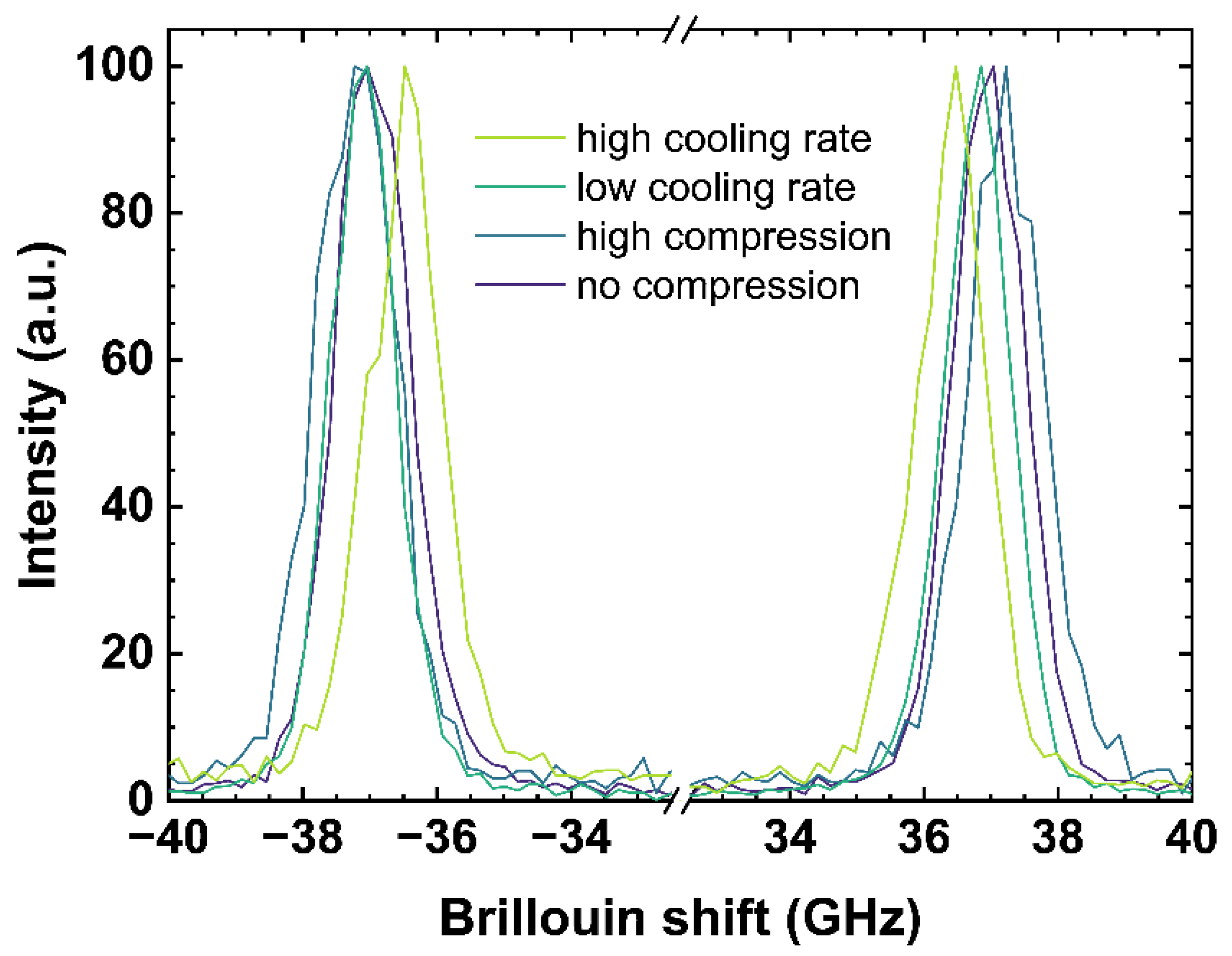
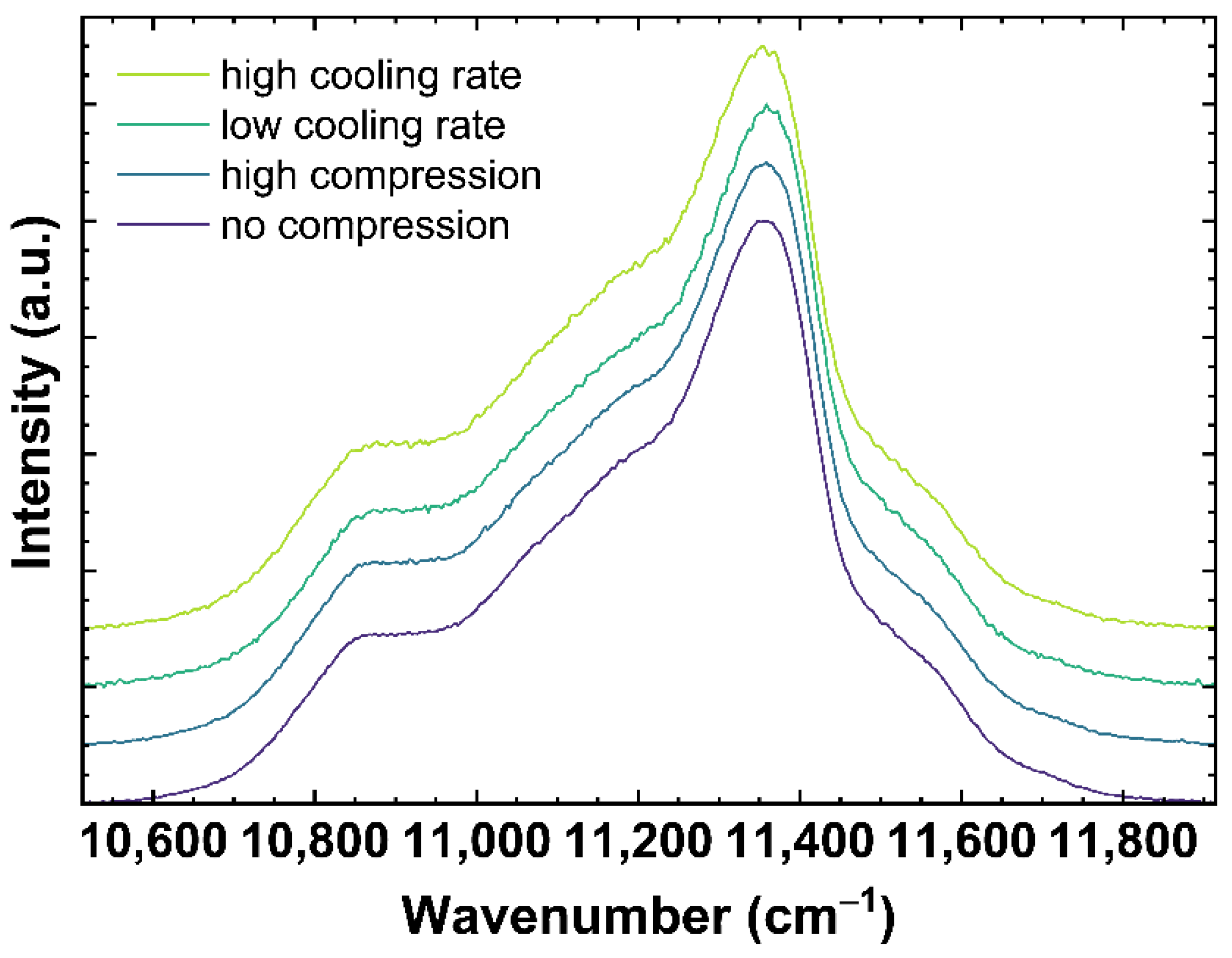

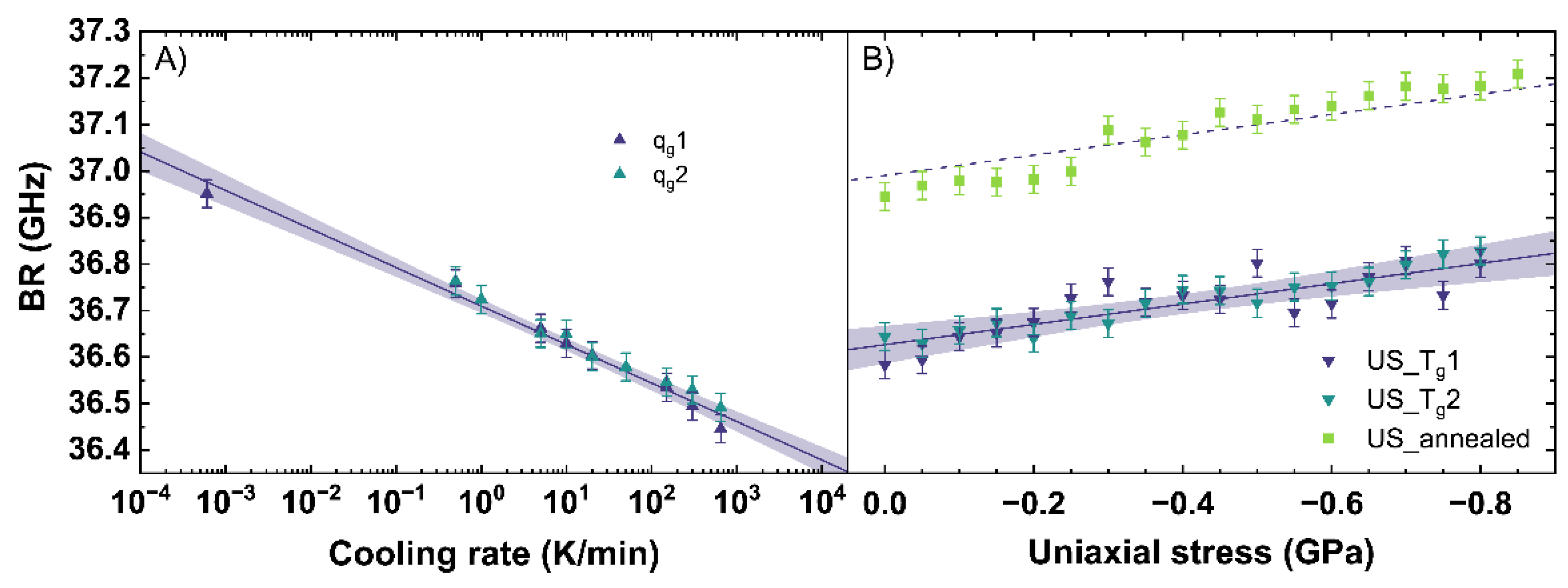
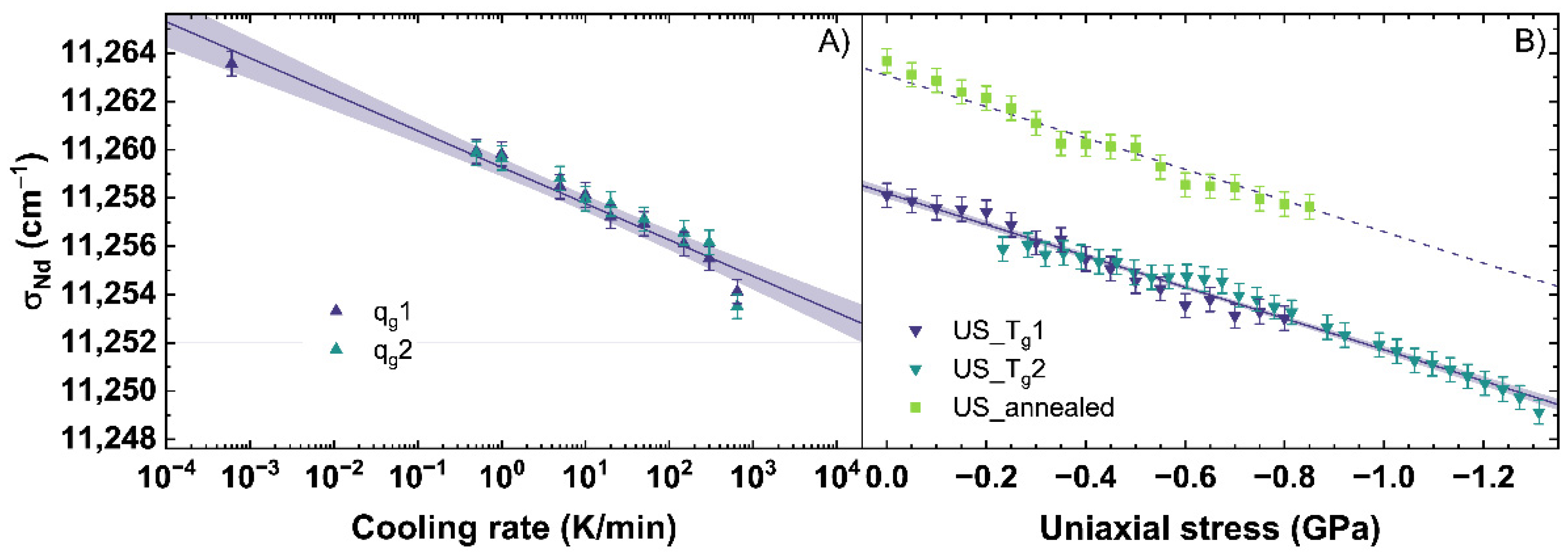


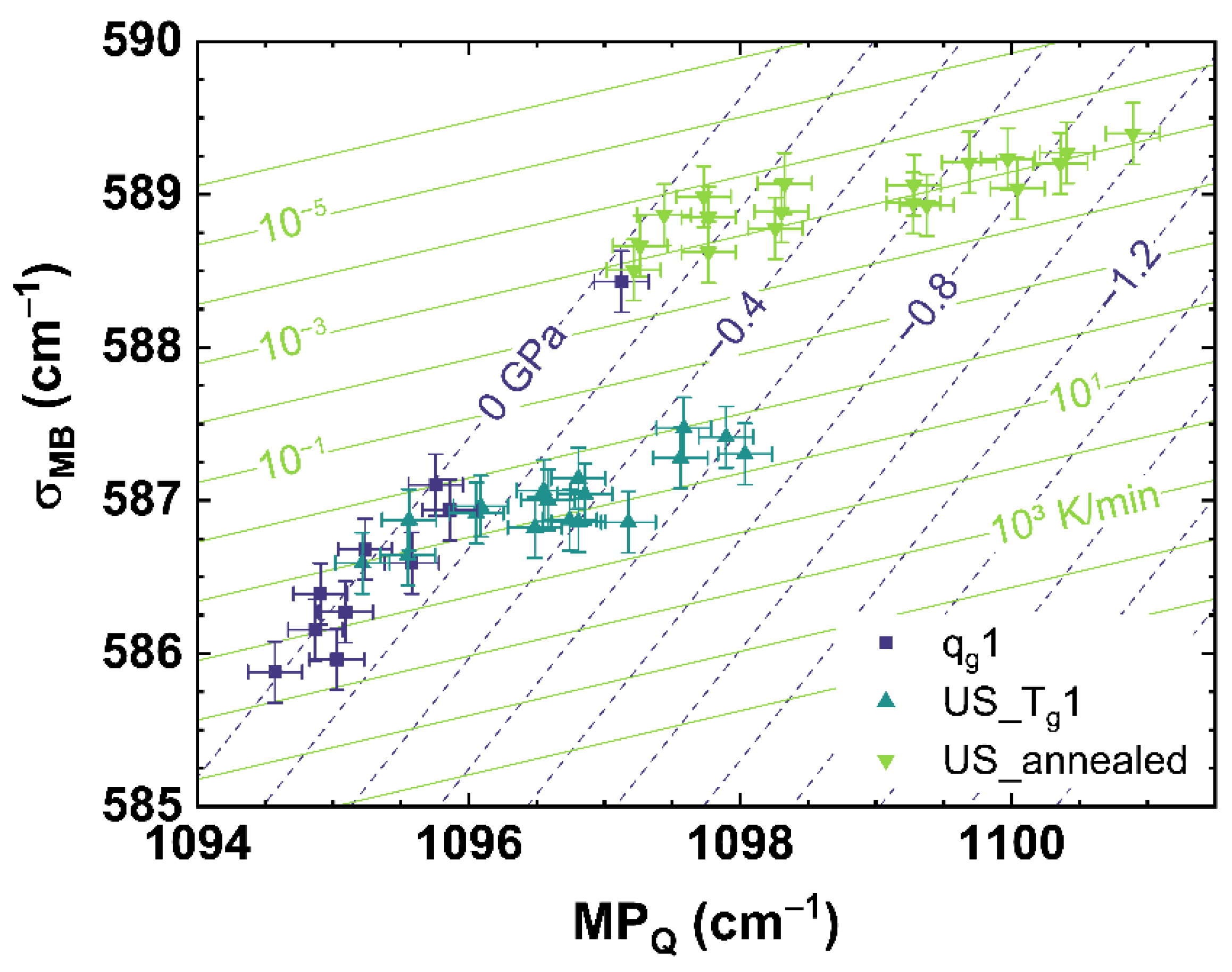
Publisher’s Note: MDPI stays neutral with regard to jurisdictional claims in published maps and institutional affiliations. |
© 2021 by the authors. Licensee MDPI, Basel, Switzerland. This article is an open access article distributed under the terms and conditions of the Creative Commons Attribution (CC BY) license (https://creativecommons.org/licenses/by/4.0/).
Share and Cite
Bergler, M.; Cvecek, K.; Werr, F.; Veber, A.; Schreiner, J.; Eckstein, U.R.; Webber, K.G.; Schmidt, M.; de Ligny, D. Coupling Raman, Brillouin and Nd3+ Photo Luminescence Spectroscopy to Distinguish the Effect of Uniaxial Stress from Cooling Rate on Soda–Lime Silicate Glass. Materials 2021, 14, 3584. https://doi.org/10.3390/ma14133584
Bergler M, Cvecek K, Werr F, Veber A, Schreiner J, Eckstein UR, Webber KG, Schmidt M, de Ligny D. Coupling Raman, Brillouin and Nd3+ Photo Luminescence Spectroscopy to Distinguish the Effect of Uniaxial Stress from Cooling Rate on Soda–Lime Silicate Glass. Materials. 2021; 14(13):3584. https://doi.org/10.3390/ma14133584
Chicago/Turabian StyleBergler, Michael, Kristian Cvecek, Ferdinand Werr, Alexander Veber, Julia Schreiner, Udo R. Eckstein, Kyle G. Webber, Michael Schmidt, and Dominique de Ligny. 2021. "Coupling Raman, Brillouin and Nd3+ Photo Luminescence Spectroscopy to Distinguish the Effect of Uniaxial Stress from Cooling Rate on Soda–Lime Silicate Glass" Materials 14, no. 13: 3584. https://doi.org/10.3390/ma14133584






